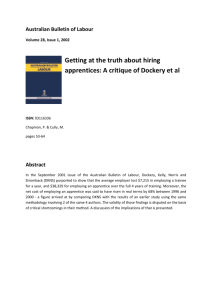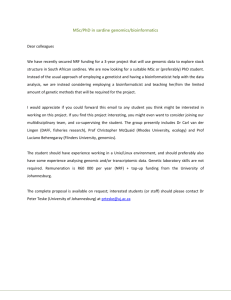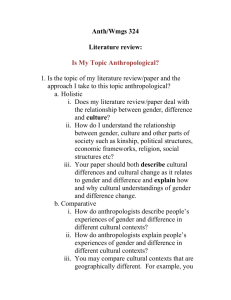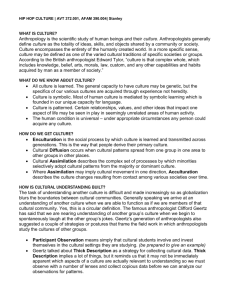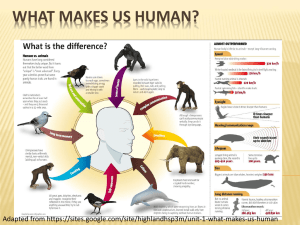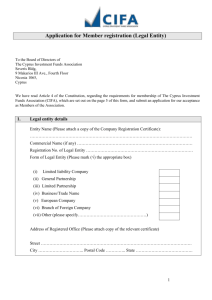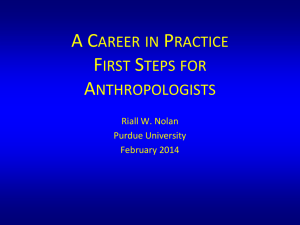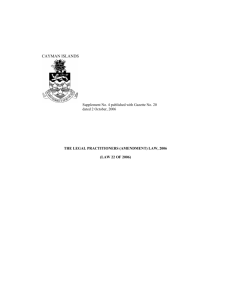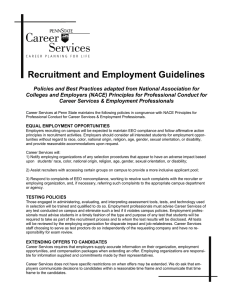Class is the only significant ethnographic issue
advertisement
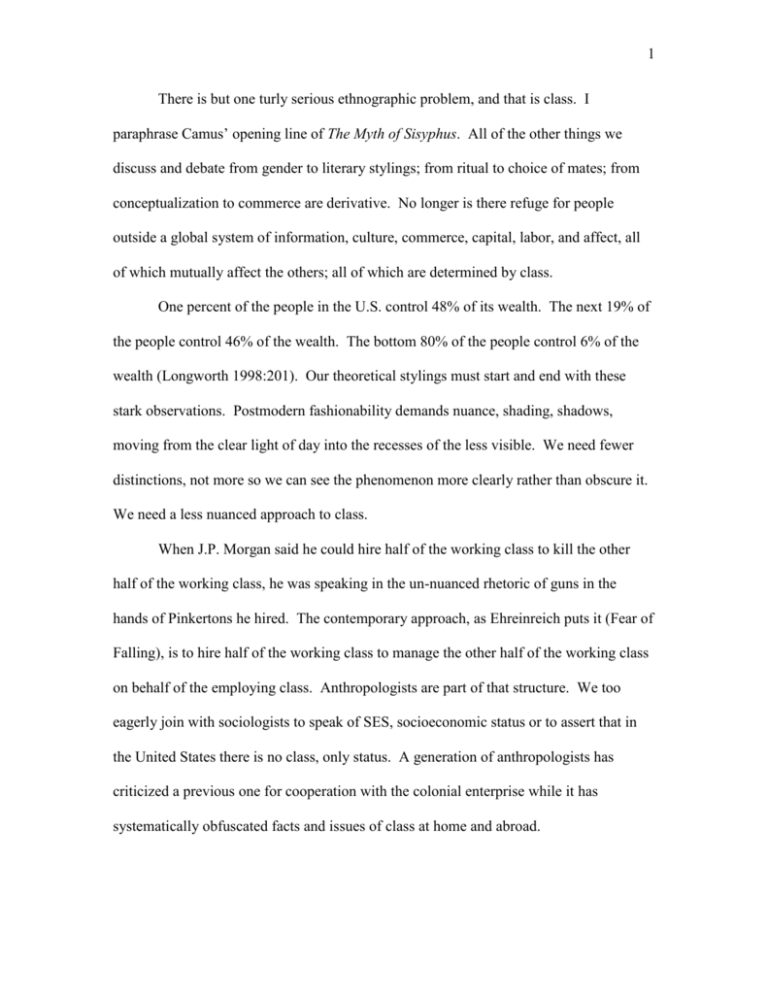
1 There is but one turly serious ethnographic problem, and that is class. I paraphrase Camus’ opening line of The Myth of Sisyphus. All of the other things we discuss and debate from gender to literary stylings; from ritual to choice of mates; from conceptualization to commerce are derivative. No longer is there refuge for people outside a global system of information, culture, commerce, capital, labor, and affect, all of which mutually affect the others; all of which are determined by class. One percent of the people in the U.S. control 48% of its wealth. The next 19% of the people control 46% of the wealth. The bottom 80% of the people control 6% of the wealth (Longworth 1998:201). Our theoretical stylings must start and end with these stark observations. Postmodern fashionability demands nuance, shading, shadows, moving from the clear light of day into the recesses of the less visible. We need fewer distinctions, not more so we can see the phenomenon more clearly rather than obscure it. We need a less nuanced approach to class. When J.P. Morgan said he could hire half of the working class to kill the other half of the working class, he was speaking in the un-nuanced rhetoric of guns in the hands of Pinkertons he hired. The contemporary approach, as Ehreinreich puts it (Fear of Falling), is to hire half of the working class to manage the other half of the working class on behalf of the employing class. Anthropologists are part of that structure. We too eagerly join with sociologists to speak of SES, socioeconomic status or to assert that in the United States there is no class, only status. A generation of anthropologists has criticized a previous one for cooperation with the colonial enterprise while it has systematically obfuscated facts and issues of class at home and abroad. 2 The spectre that haunted Europe, that frightful hobgoblin that stalked through Europe, as the first English translation of the Communist Manifesto put it (Wheen1999:124), has been laid to rest and now the demands of the manifesto look curiously like something from a platform of an acceptable American political party respectably engaged in electoral politics and the American Communist Party had only half the card carrying membership of the American Anthropological Association when their long-time octagenerian leader Gus Hall died in the year 2000. Did we notice the spectre? We chronicle nuances of resistance to hegemony without talking about a ruling class. We play with consequences and dare not discuss causes. What happened to the working class that was so clearly visible to the Industrial Workers of the World that they could unambiguously state in the preamble to their constitution that there are but two clases—the employing class and the working class and they have nothing in common? J.P. Morgan furnished part of the answer. He and the employing class hired the guns. That’s no joke. Consider the alternatives for class consciousness. One is discussion. In the last century Peter Kropotkin pointed out the pitfalls of the right to free speech. In Great Britain revolutionists, persecuted and chased from Europe, could speak as openly as they pleased, publish what they wanted, discuss as openly as they desired as long as they did not do anything untoward. In Tsarist Russia to even think or speak in subversive tones demanded organization into paranoid secret societies. The cost of freedom of speech was organization. The observation is still appropriate. When the rage of impotence moves people to arms they are met with sure and swift and overwhelming violence from any one of a number of government agencies from Alcohol, Firearms and Tobacco to the Cost Guard 3 to the National Guard or a local Special Weapons and Tactics Team likely trained if nor armed by the Department of Defense. It seems almost every agency of government has it’s own goon squad. For those agencies that do not maintain their own means of violence there is the all-purpose Federal Bureau of Investigation. The examples are all too frequent in the news from Ruby Ridge to Waco to either example of Wounded Knee to the latest worker gone postal or whack-o with a gun taking as many others as possible with him to the next life. What Scott observed of Indonesian peasants is true of other stratified societies— not only are people not fooled by ruling class symbolic or ritual proclamations but they also know from hard won experience that head-on resistance only results in tragedy. It may be that every generation in every land must pay a price in blood to learn that lesson but what the peasants taught the Yale scholar remains is true. The safer alternative is to remain within the law and try to organize for common purposes. Some countries such as the Scandinavian ones, demand it. But even this element of corporatist states is weakening under the hammer of global economics as manufacturing moves its well paying jobs to the cheap labor markets of the third world to achieve greater profits for shareholders, save on their tax bill, undercut the tax base, and threaten the social contract that has underwritten class co-operation on mutually agreed terms. Other lands, such as the United States, incorporate into law charters for the employing class to systematically prevent such cooperation and destroy whatever gains the working class may threaten to make through organization. The Taft-Hartley amendments to the Wagner Act are examples. As Miriam Wells ()points out, local and national administrative interpretation of the law is another avenue. The third avenue is 4 the inevitable and tragically predictable internal collapse of organized labor under the weight of it’s own political necessities (D&E) and personal proclivities (C.W. Mills). Democratic societies provide the option of victory through their electoral processes. Economist John Kenneth Galbraith (1992) documents how this system works only for those for whom it works. Most of that lowest 80% of the population of the U.S. is so ill served by the political system that it is a waste of their time and effort to participate in it even to the extent of voting. The 40% of the population who either are well served by the political system or who can come to think of themselves as possibly served by it, participate in the process and continually re-invent it to serve their interests—those of the employing class and that part of the working class that serves them. As Galbraith points out, all that’s left is for the employing class to hire some academics to proclaim that they do not even exist to make the sham complete. This explains our unwillingness to address clearly issues of class. We are implicated in the process of obscurantism. Why else does the American Anthropological Association see in two worker households that sometimes don’t even manage to stay above the level of poverty a working middle class instead of the working class? Why else do anthropologists endlessly discuss nuances of their own north-eastern suburban high school days? Why else do we avoid the issue of class and obscure it so thoroughly? It’s time we quit it. 5 References Cited Camus, Albert 1955 The Myth of Sisyphus and Other Essays. New York: Vintage Books. Galbraith, John Kenneth 1992 The Culture of Contentment. Boston: Houghton Mifflin Company. Longworth, Richard C. 1998 Global Squeeze: the Coming Crisis for First-World Nations. Chicago: Contemporary Books. Wheen, Francis 1999 Karl Marx. London: Fourth Estate.
